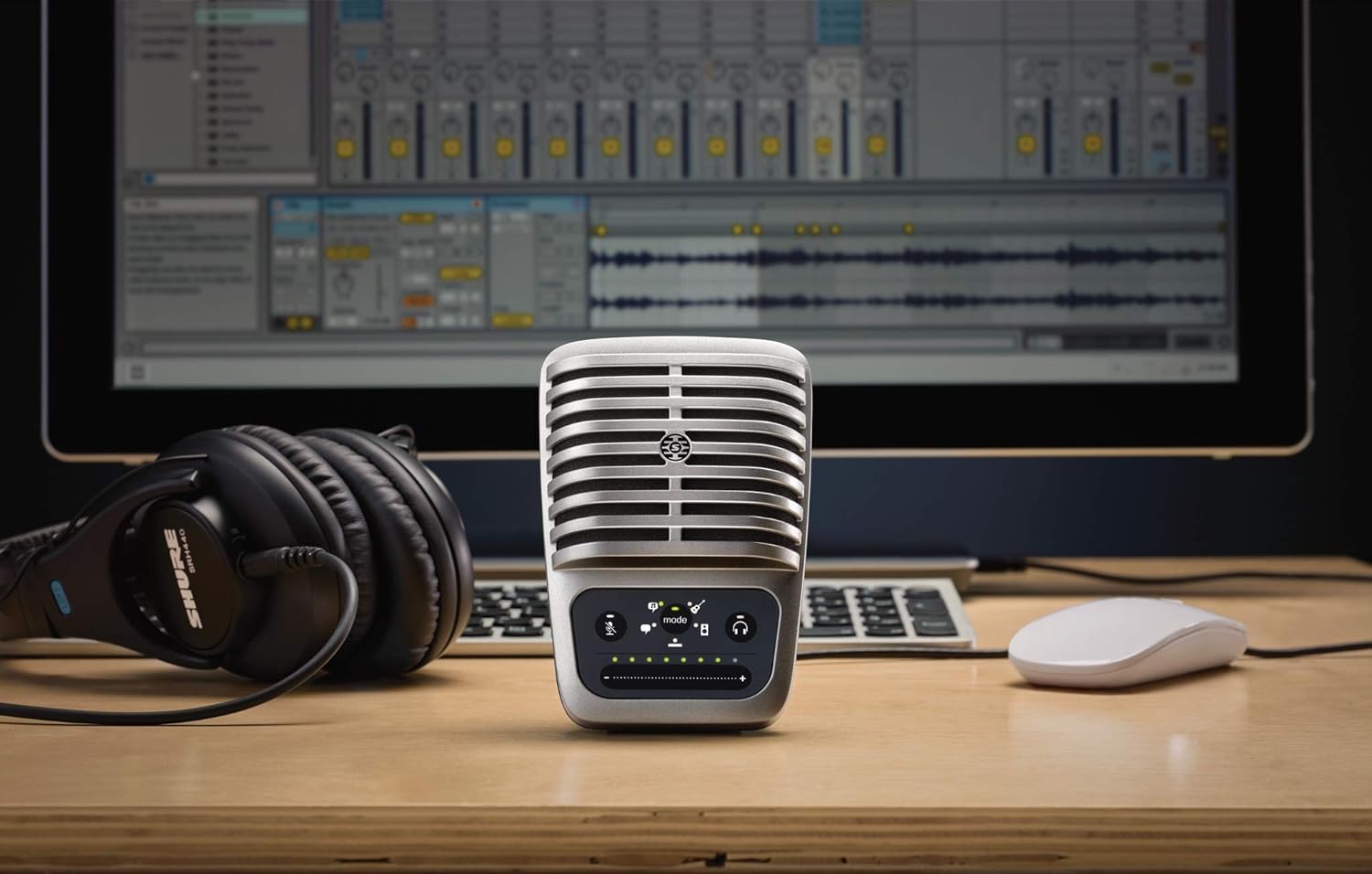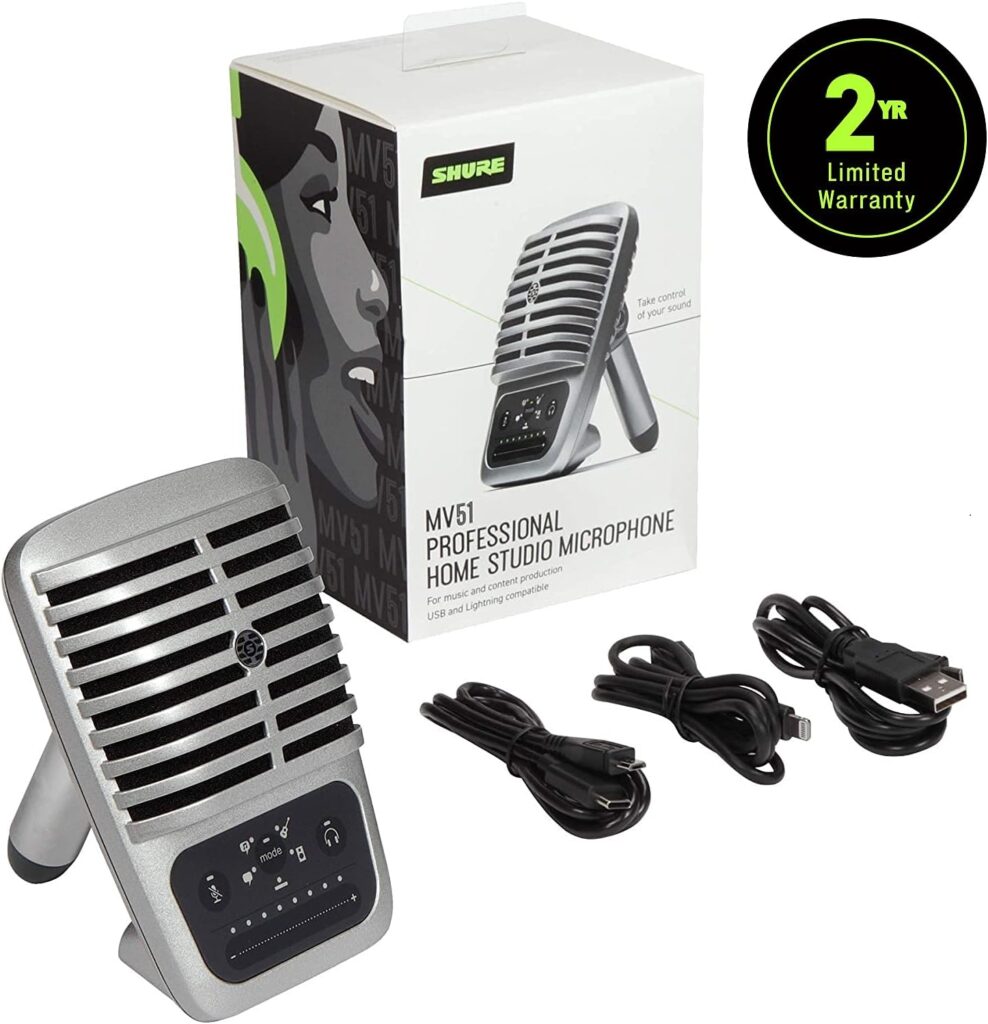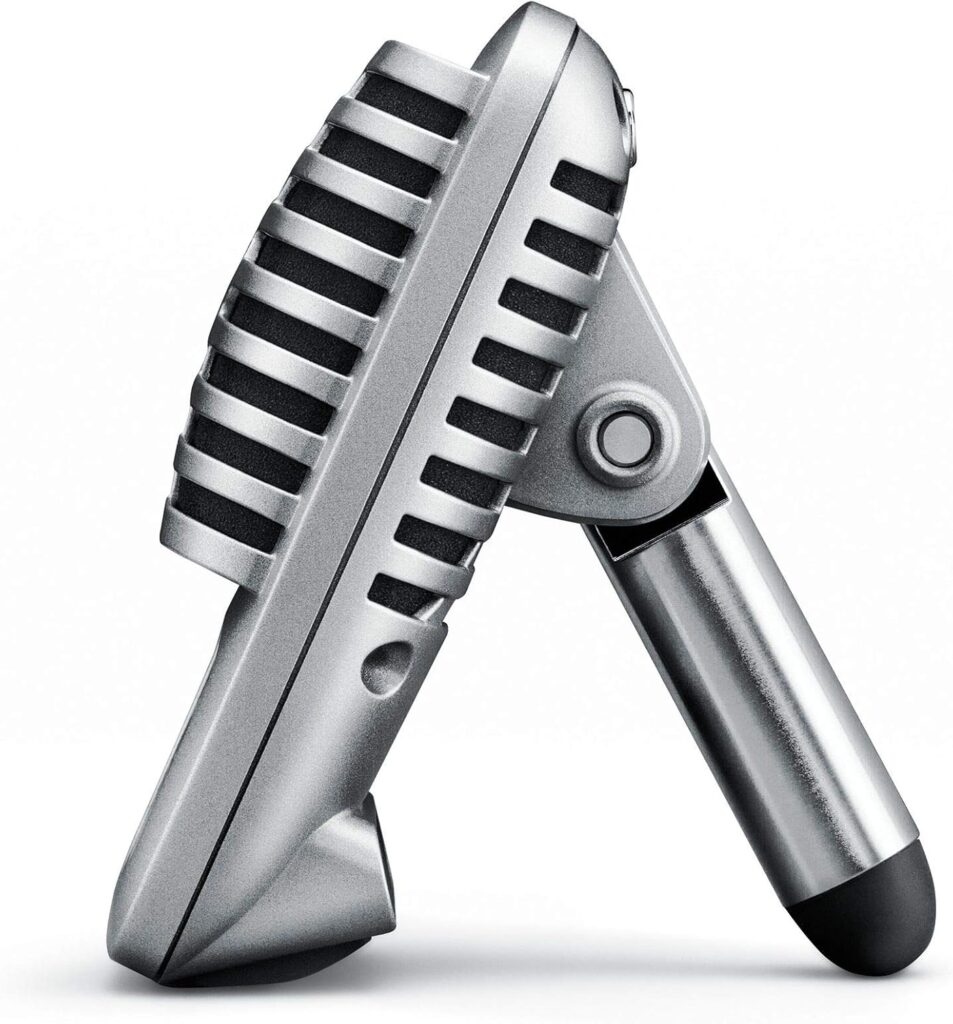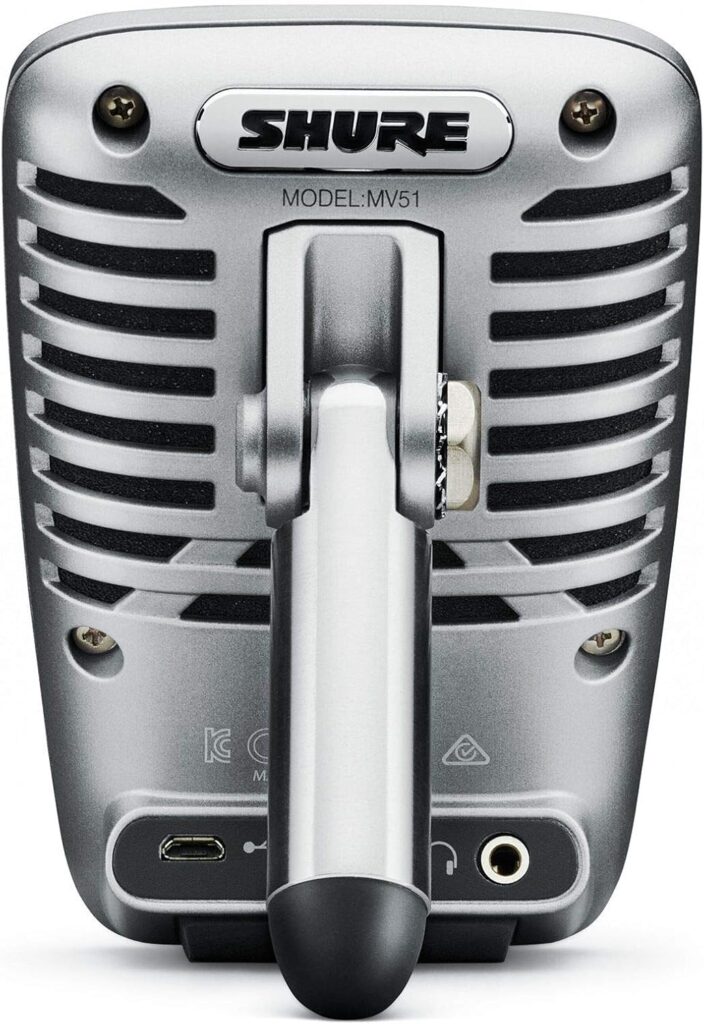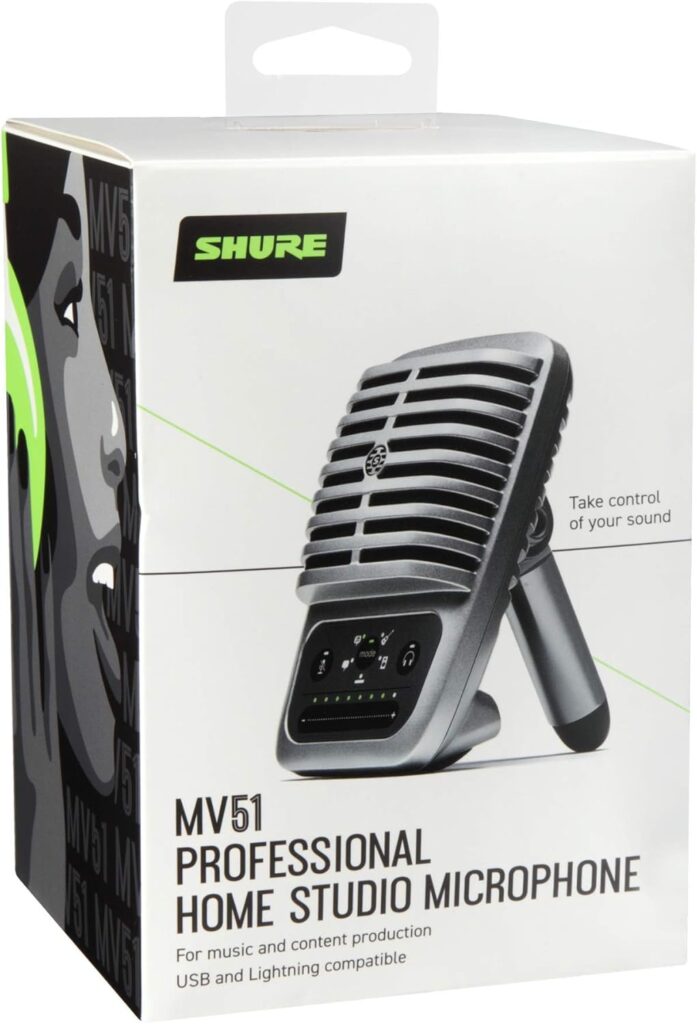Shure MV51 Review
When it comes to microphones, Shure is a name that resonates with quality, durability, and innovation. Known for iconic models like the SM58 and SM7B, the company has built a reputation for delivering tools that professionals and enthusiasts alike can rely on. Enter the Shure MV51, a digital large-diaphragm condenser microphone from the MOTIV series, designed to bridge the gap between vintage aesthetics and modern functionality. With its retro-inspired design, USB and Lightning connectivity, and a suite of digital signal processing (DSP) presets, the MV51 promises versatility for podcasters, musicians, streamers, and anyone looking to capture high-quality audio with minimal fuss. But does it live up to the hype? In this in-depth review, we’ll explore the MV51’s design, features, sound quality, usability, and overall value to help you decide if it’s the right microphone for your needs.
Shure MV51: Design and Build Quality
The moment you unbox the Shure MV51, it’s clear that this isn’t your average USB microphone. With a gleaming chrome grille and a sturdy, all-metal construction, the MV51 evokes the classic look of Shure’s 1950s Model 51 Sonodyne—a microphone that oozes retro charm. It’s a striking departure from the sleek, minimalist designs of many modern USB mics, and that’s part of its appeal. Measuring roughly 5 inches tall, 3.4 inches wide, and 2.8 inches deep, it’s compact enough to fit on a desk but substantial enough to feel like a premium piece of gear. Weighing in at over a pound, the MV51 is noticeably heavier than many competitors, a testament to its robust build.
The microphone’s body is crafted from solid metal, giving it a tank-like durability that aligns with Shure’s legendary reputation for ruggedness. Whether you’re tossing it into a backpack for mobile recording or setting it up in a home studio, the MV51 feels like it can withstand the rigors of regular use. On the back, a pivoting kickstand with a rubberized foot allows for tabletop positioning at various angles, making it ideal for podcasting or video calls. Unscrew the rubber foot, and you’ll reveal a threaded socket compatible with standard microphone stands—a clever touch that enhances its versatility.
The front of the MV51 features a touch-sensitive control panel, illuminated by LED indicators. This panel lets you adjust gain, headphone volume, mute the mic, and cycle through five DSP presets (more on those later). The controls are responsive and intuitive, though the lack of tactile feedback might take some getting used to for users accustomed to physical buttons or knobs. On the rear, you’ll find a micro-USB port for connectivity and a 3.5mm headphone jack for zero-latency monitoring—a must-have for real-time recording.
The package includes a 1-meter USB cable, a 1-meter Lightning cable (for iOS devices), and in newer versions, a USB-C cable, ensuring compatibility across a range of devices. While the cables are functional, their short length might be a minor inconvenience for some setups, requiring an extension or a closer device placement. Overall, the MV51’s design strikes a balance between form and function, blending nostalgic aesthetics with practical modern features.
Features: What Sets the MV51 Apart
The Shure MV51 isn’t just a pretty face—it’s packed with features that cater to a wide range of recording scenarios. At its core, it’s a large-diaphragm condenser microphone with a 1-inch (25mm) cardioid capsule, designed to capture detailed, clear audio. Unlike traditional condenser mics that require phantom power and an audio interface, the MV51 is bus-powered, drawing energy directly from your computer or mobile device via USB or Lightning. This plug-and-play simplicity makes it an attractive option for creators who want professional-grade sound without the complexity of a full studio setup.
One of the MV51’s standout features is its five onboard DSP presets: Speech, Singing, Acoustic Instrument, Loud, and Flat. These modes adjust the microphone’s EQ, compression, and limiting to suit specific recording tasks, all without the need for external software. The Speech preset, for instance, enhances clarity for spoken word, making it a favorite among podcasters and streamers. The Singing mode adds warmth and presence for vocal performances, while Acoustic Instrument is tailored for capturing the nuances of guitars or pianos. The Loud preset is designed for high-SPL sources like electric guitar amps or drums, and Flat offers an unprocessed signal for those who prefer to tweak their audio in post-production. This versatility is a major selling point, especially for beginners who might not have the expertise to manually adjust settings.
The MV51 supports 24-bit/48kHz recording, a step above the 16-bit/44.1kHz standard of many USB mics in its price range. This higher resolution ensures greater dynamic range and detail, which is particularly noticeable when recording music or layered audio. The microphone is compatible with Windows (7 or later), macOS (10.7 or later), and iOS devices (via Lightning), as well as some Android devices that support USB Audio Class 2.0 and Micro-B OTG connectivity. For iOS users, the free ShurePlus MOTIV app unlocks additional controls, including a 5-band EQ, compressor, and limiter, though these advanced features are exclusive to Apple devices at the time of writing.
The built-in headphone jack provides zero-latency monitoring, allowing you to hear your input in real time alongside playback from your device—a crucial feature for overdubbing or live streaming. The touch panel’s mute button is another thoughtful addition, offering instant control during recordings or calls. While the MV51’s cardioid polar pattern is fixed (unlike some mics that offer multiple patterns), it’s well-suited for most solo recording tasks, effectively rejecting off-axis noise.
Sound Quality: How Does It Perform?
The true test of any microphone is its sound quality, and the MV51 delivers a performance that’s impressive for its class. Thanks to its large-diaphragm capsule, the microphone captures audio with a clean, detailed character. In Flat mode, the MV51 produces a neutral sound with a slight emphasis on the low end, courtesy of its extended bass response. This makes it particularly adept at recording deep voices, vocals, or instruments like bass guitars and kick drums. The midrange is smooth and present, though some users might notice a subtle coloration that’s less pronounced in higher-end studio condensers. The high frequencies are clear without being harsh, though they lack the airy sparkle of mics with smaller diaphragms or more sophisticated preamps.
When close-miking vocals (within 6-12 inches), the MV51 shines, delivering a rich, full-bodied sound with minimal self-noise. The proximity effect enhances bass response up close, which can be a boon for vocalists or podcasters seeking a warm tone—just be sure to use a pop filter to tame plosives. For speech, the Speech preset adds clarity and cuts through background noise effectively, making it a strong choice for Zoom calls or podcast episodes. The Singing preset boosts presence and smooths out dynamics, though it might feel slightly compressed for users who prefer a raw signal.
Recording acoustic instruments reveals the MV51’s strengths and limitations. It handles the nuances of an acoustic guitar well in Acoustic mode, capturing fingerpicking and strumming with decent fidelity. However, when positioned farther from the source (beyond 18 inches), the sound can become less focused, with some off-axis coloration creeping in. For louder sources like electric guitar amps, the Loud preset manages high sound pressure levels (up to 130 dB SPL) without distortion, though the mic’s sensitivity means it can pick up room noise if not carefully positioned.
Compared to competitors like the Blue Yeti or Audio-Technica ATR2100x, the MV51 holds its own in terms of clarity and build quality. It doesn’t offer the same multi-pattern flexibility as the Yeti, but its DSP presets and iOS compatibility give it an edge for mobile creators. Against Shure’s own MV5 (a smaller sibling), the MV51 offers a fuller sound and more features, though at a higher price and weight.
Usability: Plug-and-Play with a Learning Curve
Setting up the MV51 is a breeze. Plug it into your computer via USB, and it’s recognized instantly—no drivers required for most systems. On iOS, connect it with the Lightning cable, open the ShurePlus MOTIV app (or another recording app like GarageBand), and you’re ready to go. The touch panel simplifies adjustments on the fly, though its sensitivity might lead to accidental changes if you’re not careful. The LED indicators are helpful for monitoring settings, but they’re not as detailed as a full software interface.
For beginners, the DSP presets are a godsend, offering pre-tuned options that reduce the need for post-processing. More advanced users might prefer the Flat mode paired with a DAW like Audacity or Pro Tools, where they can fine-tune the signal to their liking. The headphone monitoring works flawlessly, blending mic input and device playback seamlessly. However, the lack of Android app support (as of early 2025) and the short included cables might frustrate some users, requiring workarounds like adapters or extensions.
The kickstand is sturdy for desktop use, but its low height means you’ll need to hunch over or adjust your setup for optimal positioning. Mounting it on a stand solves this, though the mic’s weight demands a robust stand—cheap scissor arms might struggle to hold it steady. Overall, the MV51 is user-friendly yet versatile enough to grow with your skills.
Pros and Cons
Pros:
- Stunning retro design with a durable, all-metal build.
- Versatile DSP presets for various recording scenarios.
- High-quality 24-bit/48kHz audio with low self-noise.
- USB and Lightning connectivity for broad compatibility.
- Zero-latency headphone monitoring for real-time recording.
- Solid performance for vocals, instruments, and speech.
Cons:
- Heavy and less portable than some USB mics.
- Short cables may limit setup flexibility.
- Fixed cardioid pattern lacks multi-pattern options.
- Midrange coloration might not suit all tastes.
- Advanced app features limited to iOS users.
- Pricey compared to entry-level USB mics.
Who Is It For?
The Shure MV51 is a jack-of-all-trades microphone that appeals to a diverse audience. Podcasters will appreciate its Speech preset and desktop-friendly design, while musicians can leverage its Singing and Acoustic modes for home recordings. Streamers and content creators benefit from its plug-and-play simplicity and professional sound, and its iOS compatibility makes it a go-to for mobile recording on the go. However, if you need a lightweight, ultra-portable mic or multiple polar patterns for complex setups, you might look elsewhere.
Final Thoughts
The Shure MV51 is a compelling blend of style, substance, and versatility. Its retro design turns heads, while its modern features—DSP presets, high-resolution audio, and multi-device compatibility—make it a practical tool for creators. The sound quality is excellent for a USB condenser, particularly for close-miking and speech, though it’s not without quirks like midrange coloration and limited portability. For podcasters, vocalists, and home studio enthusiasts who value ease of use and durability, the MV51 is a worthy investment. If you’re on a tighter budget or need a lighter mic, alternatives might suit you better, but the MV51’s unique charm and performance make it a standout in its class.
In a world where audio gear often prioritizes function over form, the Shure MV51 dares to do both. It’s not perfect, but it’s a microphone that delivers on its promise: professional sound with a touch of personality. Whether you’re recording your next hit, hosting a podcast, or chatting on a video call, the MV51 is ready to make you sound your best.

